| Origami Heaven A paperfolding
paradise
The website of
writer and paperfolding designer David Mitchell
x
|
| |
| Designs Made Using
Mock Platinum Folding Geometry |
|
| |
Where the
designs are not otherwise attributed they are my own.
|
| |
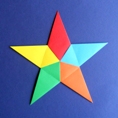 |
|
Pentangle
- a 5-part design from squares using mock
platinum folding geometry. On-line diagrams are
available on the Modular Designs page of this site.
|
|
| |
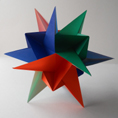 |
|
I created the Semi-Star design
in 1988 by turning the points of the modules for
Robert Neale's Octahedron outwards using mock
platinum folding geometry. Diagrams can be
found in Paper Crystals - David Mitchell - Water
Trade - ISBN 9780953477494.
|
|
| |
 |
|
The form of Andromeda
is made by completing the points of the
Semi-Star. The basic form is stable when made
from twelve modules. The version pictured here
has been enhanced by the addition of six end caps
which allow the central nolid octahedron to be
coloured separately from the points of the star. Diagrams can be
found in Paper Crystals - David Mitchell - Water
Trade - ISBN 9780953477494.
|
|
| |
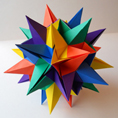 |
|
Andromeda 60
is an icosahedral version of Andromeda assembled
from sixty modules folfed from square using mock
platinum folding geometry. It is a stable but
quite delicate design. Diagrams can be
found in Paper Crystals (2nd Edition) -
Water Trade - ISBN 978-0-9534774-9-4.
|
|
| |
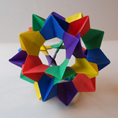 |
|
Electra
is a beautiful sculpture that can, rather
prosaically, be described as a pierced decorative
icosidodecahedron. It is assembled from thirty
modules folded from squares using mock platinum
folding geometry. Diagrams can be found in Paper Crystals (2nd Edition) -
Water Trade - ISBN 978-0-9534774-9-4.
|
|
| |
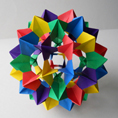 |
|
Electra 60
is is a beautiful sculpture, technically a
pierced decorative rhombicosidodecahedron, made
from 60 squares. The picture shows a five colour
version but the sculpture is probably at its best
when made from paper decorated with a random or
organic design. Diagrams can be found in Paper Crystals (2nd Edition) -
Water Trade - ISBN 978-0-9534774-9-4.
|
|
| |
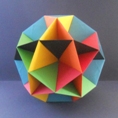 |
|
My Nolid (or
Skeletal) Icosidodecahedron can be
conceived of as composed of six interpenetrating
decagons. The modular method allows each of these
six decagons to be made in paper of a different
colour. This design holds together sufficiently
well for display purposes but needs careful
handling. You would certainly not want to throw
it across the room. Diagrams are not yet
available.
|
|
| |
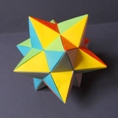 |
|
The 60-part method
for this Small Stellated Dodecahedron
allows each of the five-pointed stars to be
coloured individually. The design is stable but
not robust. The module is folded using mock
platinum folding geometry. The module was first
designed in 1990 but updated in 2016. Diagrams are not yet
available.
|
|
| |
| |